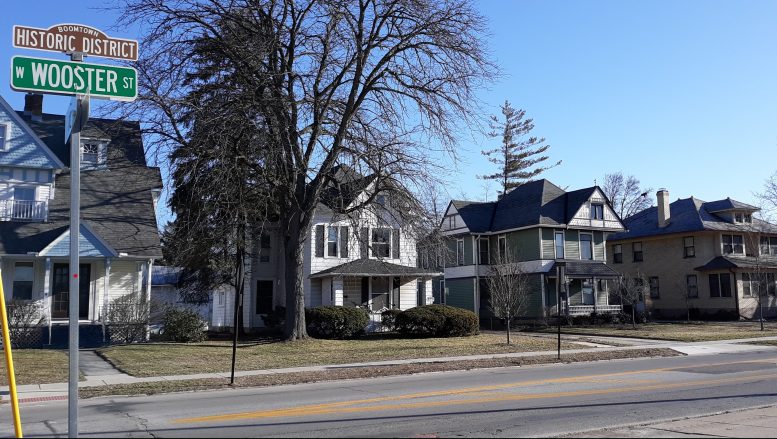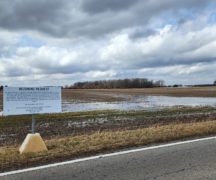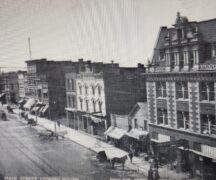By JAN LARSON McLAUGHLIN
BG Independent News
Bowling Green is trying to find a balance between the rights of personal property owners and the desire to preserve historic buildings in the community.
After nearly two years of working on a plan, the city’s Historic Preservation Committee presented its proposal to the Bowling Green Planning Commission last week.
The goal of the historic preservation plan is to help the city retain historically significant structures.
“We are charged with helping Bowling Green celebrate its rich historic past,” said John Sampen, chair of the city’s historic preservation commission.
The first step is getting Certified Local Government status for the city. That would allow the community to create a plan, and make it possible for homeowners and businesses to get grants and tax credits to protect historic buildings.
Bowling Green is the only university city in Ohio that doesn’t already have the ability to create an historic preservation plan, according to those trying to remedy what they see as a deficiency.
There are 78 cities in the state that have Certified Local Government status. The effort has been made before – but suspicions and very vocal objections by a few citizens killed the effort six years ago.
The commission’s goal is to “preserve, promote, encourage and support the maintenance, use and reuse of historic buildings in the city.” In other words, it would help property owners who want to preserve historic structures.
Some historic homes are losing the battle against time and rental transformation. And the longer the preservation efforts are on hold, the more some structures deteriorate, commission members have said.
“We want to avoid any further decline in historic structures,” commission member Les Barber said last year about the plans. “If you look at what’s happening in these areas, homes come up for sale, they get bought by landlords, and they start disintegrating.”
Barber clarified that not all landlords allow properties to deteriorate.
“But in general, they decline,” he said. “Then that reduces the general appeal that Bowling Green has.”
“A pattern has been visible for years,” Barber said last week.
It is expected that multiple historic overlay zoning districts would be created in the city – if the majority of the property owners in the areas support the idea.
The objective of historic preservation is to protect the historic integrity of buildings – and help when possible with restorations. It is not to nitpick and tell homeowners what they can and cannot do with their properties, commission members have stressed.
“We want to be a flexible board that works with people,” Sampen said.
The plan would require property owners in designated historic areas to meet standards when making substantive changes to the exterior of buildings. There would be no rules for the interior of structures.
Sampen stressed that there would be no requirements for property owners to meet – unless they are making major exterior changes to historical structures.
“My hat is off to you folks for all the work you have put into this,” said Jeff Betts, chairman of the city planning commission.
However, Betts and other members of the planning commission expressed concerns that the historic preservation plan could adversely affect landowners who don’t wish to be involved.
“It could put them at the mercy of their neighbors,” he said.
While the formation of the historic preservation districts would require approval by a majority of the property owners, Betts suggested that the plans only cover small patches where all the landowners who want to join. Eventually, the patches could become a “full-fledged quilt,” he said.
Barber said the historic prevention plan is intended to benefit the entire city.
“It’s a question of what’s good for the community as a whole,” he said. “We believe there is an advantage to having an opportunity for protected historic districts.”
According to Barber, the benefits of a plan for historic preservation include:
- Fostering historic pride in the community.
- Contributing to the quality of life.
- Offering tax incentives and loans.
- Protecting neighborhoods and the downtown.
- Encouraging revitalization of unique buildings and structures.
- Promoting recognition and interest for local history.
Planning commission member Nate Spitler said the historic district plan is unlike a homeowner association – in which property owners know the rules prior to buying a home.
Planning commission members Kris Phillips and Will Airhart suggested that current property owners be grandfathered, so future landowners have to meet the historic standards when major exterior changes are made.
“I think having an historic district is going to be really good for the community,” Airhart said.
The role of the commission is not to protect individual landowners, Airhart said, but rather ask the question “Would this be good for the community as a whole?”
Planning commission members suggested that the historic preservation commission make some revisions and then return to the planning commission. The plan will then be discussed at a City Council public hearing.
“We appreciate your sparring with us a little bit,” Sampen said to the planning commission, noting the importance of getting the plan right. “We have a lot of history to celebrate.”





